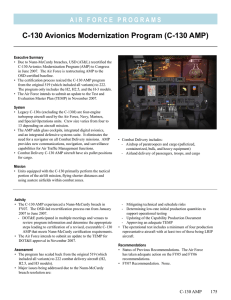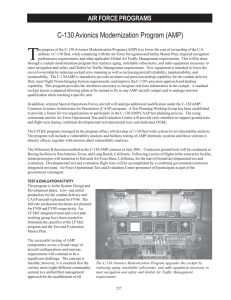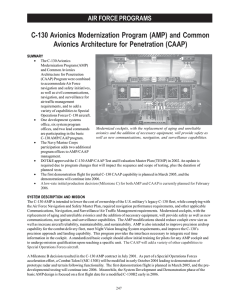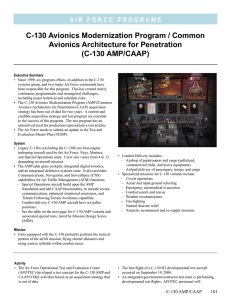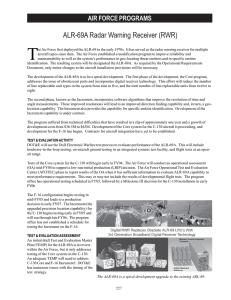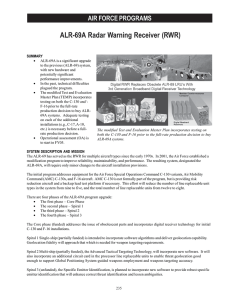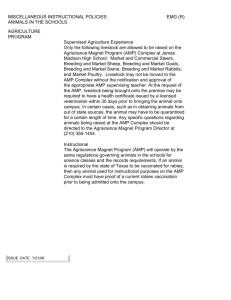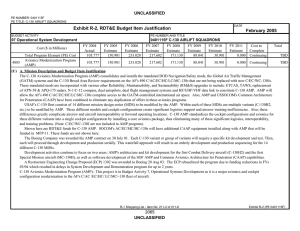C-130 Avionics Modernization Program/Common Avionics Architecture for Penetration (C-130 AMP/CAAP)
advertisement
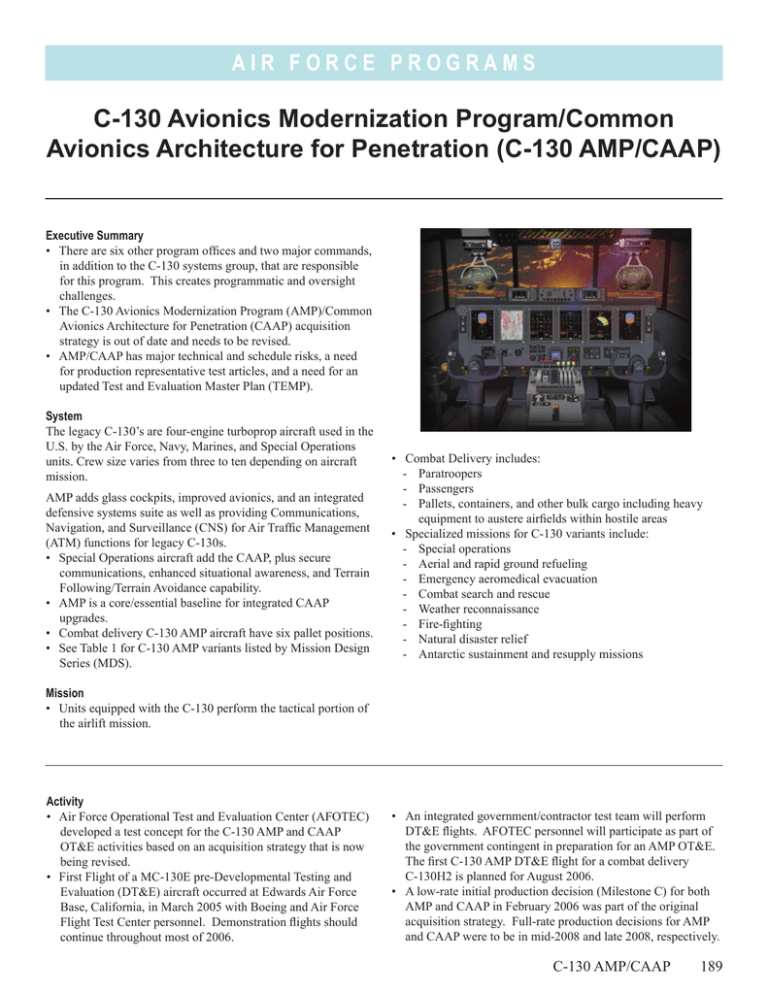
AIR FORCE PROGRAMS C-130 Avionics Modernization Program/Common Avionics Architecture for Penetration (C-130 AMP/CAAP) Executive Summary • There are six other program offices and two major commands, in addition to the C-130 systems group, that are responsible for this program. This creates programmatic and oversight challenges. • The C-130 Avionics Modernization Program (AMP)/Common Avionics Architecture for Penetration (CAAP) acquisition strategy is out of date and needs to be revised. • AMP/CAAP has major technical and schedule risks, a need for production representative test articles, and a need for an updated Test and Evaluation Master Plan (TEMP). System The legacy C-130’s are four-engine turboprop aircraft used in the U.S. by the Air Force, Navy, Marines, and Special Operations units. Crew size varies from three to ten depending on aircraft mission. AMP adds glass cockpits, improved avionics, and an integrated defensive systems suite as well as providing Communications, Navigation, and Surveillance (CNS) for Air Traffic Management (ATM) functions for legacy C-130s. • Special Operations aircraft add the CAAP, plus secure communications, enhanced situational awareness, and Terrain Following/Terrain Avoidance capability. • AMP is a core/essential baseline for integrated CAAP upgrades. • Combat delivery C-130 AMP aircraft have six pallet positions. • See Table 1 for C-130 AMP variants listed by Mission Design Series (MDS). • Combat Delivery includes: - Paratroopers - Passengers - Pallets, containers, and other bulk cargo including heavy equipment to austere airfields within hostile areas • Specialized missions for C-130 variants include: - Special operations - Aerial and rapid ground refueling - Emergency aeromedical evacuation - Combat search and rescue - Weather reconnaissance - Fire-fighting - Natural disaster relief - Antarctic sustainment and resupply missions Mission • Units equipped with the C-130 perform the tactical portion of the airlift mission. Activity • Air Force Operational Test and Evaluation Center (AFOTEC) developed a test concept for the C-130 AMP and CAAP OT&E activities based on an acquisition strategy that is now being revised. • First Flight of a MC-130E pre-Developmental Testing and Evaluation (DT&E) aircraft occurred at Edwards Air Force Base, California, in March 2005 with Boeing and Air Force Flight Test Center personnel. Demonstration flights should continue throughout most of 2006. • An integrated government/contractor test team will perform DT&E flights. AFOTEC personnel will participate as part of the government contingent in preparation for an AMP OT&E. The first C-130 AMP DT&E flight for a combat delivery C-130H2 is planned for August 2006. • A low-rate initial production decision (Milestone C) for both AMP and CAAP in February 2006 was part of the original acquisition strategy. Full-rate production decisions for AMP and CAAP were to be in mid-2008 and late 2008, respectively. C-130 AMP/CAAP 189 AIR FORCE PROGRAMS The full-rate production decision is now planned for late FY09. • AFOTEC will conduct an operational assessment of the AMP to support the Milestone C decision after the DT&E first flight of the C-130H2. Assessment • DOT&E approved a C-130 AMP/CAAP TEMP in September 2002 based upon the original acquisition strategy. An update to the TEMP is required because of program changes that impact the sequence, scope, and duration of planned tests. • Impacts on test resources and test planning have been significant due to funding issues, engineering change proposals, new aircraft to be modified, and accelerated special operations capabilities. • AFOTEC’s original test concept requires a revision following adoption of a new AMP/CAAP acquisition strategy. • There are programmatic and oversight challenges. Besides the C-130 Systems Group (the development systems office), six other program offices and two major U.S. Air Force commands are responsible for the basic C-130 AMP/CAAP. • Major technical and schedule risks, the need for production representative test articles for OT&E, multiple full-rate production decision dates, low-rate initial production quantities, revision of the Operational Requirements Documents, and TEMP approval are issues for AMP/CAAP. • Production representative aircraft in appropriate mission configurations are required for adequate operational testing of the C-130 AMP variants. Recommendations 1. Because the technical and programmatic challenges of the C-130 AMP are more evident and more numerous than those associated with the C-5 AMP, a comprehensive review of DT&E and OT&E Lessons Learned from the C-5 program should be applied. 2. DOT&E recommended in the 2004 Annual Report that, since the acquisition strategy and the testing and evaluation strategy were not consistent, a rationalization of the program should have been completed before the Special Operations Force demonstration flights began in March 2005. That rationalization is still needed. A credible acquisition strategy is essential prior to TEMP approval. Table 1. U.S. Air Force C-130 AMP Aircraft MDS Nomenclature C-130 E/H/H-1/H-2/H-3 Combat Delivery AC-130 H/U EC-130 H HC-130 N/P MC-130 E Gunship Compass Call Combat Rescue Combat Talon I MC-130 H Combat Talon II MC-130 P LC-130 H Combat Shadow Ski 190 C-130 AMP/CAAP Special Tests CNS/ATM Capabilities, Traffic Alert and Collision Avoidance System, Terrain Awareness Warning System, Night Vision Imaging System Gunfire Accuracy, Enhanced Situational Awareness, Defensive Systems Mission Unique Mission Unique Terrain Following/Terrain Avoidance Navigation Terrain Following/Terrain Avoidance Navigation, Enhanced Situational Awareness, Defensive Systems Mission Unique Mission Unique
